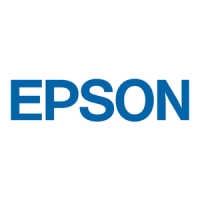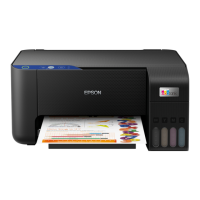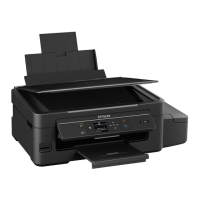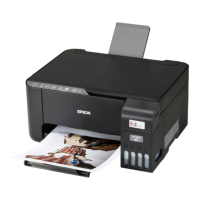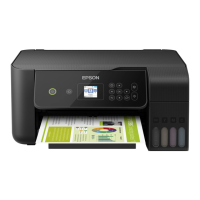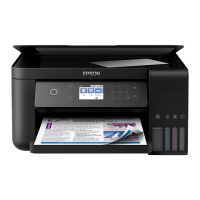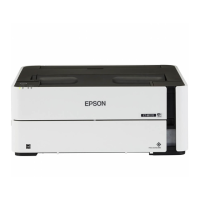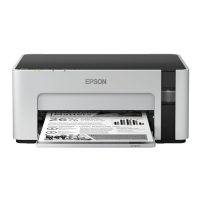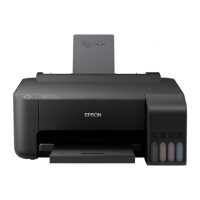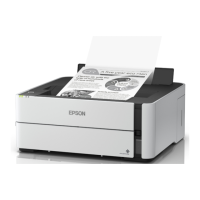Do you have a question about the Epson EcoTank L15150 and is the answer not in the manual?
Learn about the control panel and select settings.
Understand the layout and functions of the LCD screen.
Learn about the meaning of status icons displayed on the LCD.
Follow guidelines to enter characters for passwords and other settings.
View the status of your product or print jobs.
View animations on the LCD screen to help guide you with procedures.
Identify and locate the parts on the front of the product.
Identify and locate the internal parts of the product.
Identify and locate the parts on the back of the product.
Adjust the time before the product enters sleep mode and turns off the LCD.
Set the automatic product turn-off time when not in use.
Activate your product's email address for Epson Connect services.
Print from any device that can send email to your product's unique email address.
Print and scan using the Epson iPrint app on your mobile device.
Print from your laptop or desktop computer to your product anywhere in the world.
Scan and send files to online services directly from your product.
Protect your network environment using appropriate security measures.
Set up communication with your computer using a wireless router.
Set up direct communication with devices without a router.
Connect your product to a network using Wi-Fi Protected Setup.
Print a network status sheet to diagnose network problems.
Print a network connection report to view solutions to network problems.
Understand error codes and messages on the network connection report.
Configure email server settings for features like scanning to email.
Change or update how your product connects to a network.
Learn how to load paper into the product's paper cassettes.
Understand the maximum number of sheets that can be loaded in each paper source.
Information on automatic and manual double-sided printing capabilities.
List of compatible Epson paper types, sizes, part numbers, and sheet counts.
Select the correct paper type or media type setting in the printing software.
Change default paper size and type via the control panel.
Adjust default paper settings for all print jobs as an administrator.
Instructions for placing documents on the scanner glass for copying or scanning.
Instructions for placing documents in the ADF for copying or scanning.
Steps to copy documents or photos using the product.
Select various options to customize your copied documents.
Instructions for printing documents from Windows applications.
Print using the built-in driver on Windows 10 S.
Instructions for printing documents from Mac applications.
Methods to start scanning your originals.
Scan to various destinations using the product's control panel.
Scan and email files using the product's control panel.
Scan and save files to a connected computer.
Scan and save images to an external USB device.
Send scanned files to destinations registered with Epson Connect.
Create a shared folder and register its location for network scanning.
Start Epson Scan 2 to select settings, scan, and save images.
Start Epson Scan 2 from a TWAIN-compliant scanning program.
Scan from a smart device using the Epson iPrint app.
Enter user ID and password if Access Control is enabled for scanning.
Scan and review documents and photos using Epson ScanSmart software.
Connect your product to a telephone wall jack to send or receive faxes.
Set up fax header and select desired fax features.
Learn how to send faxes using your product.
Learn how to receive faxes with your product.
Check the status of current fax jobs or received/sent faxes.
Print fax reports and logs for troubleshooting and status checks.
Follow important safety guidelines for handling ink bottles and tanks.
Check ink and maintenance box levels on your product and via software.
Learn how to refill the ink tanks with new ink bottles.
Instructions for replacing the maintenance box when it is full.
Perform maintenance on the print head to improve quality.
Run a Power Cleaning to resolve severe print quality issues.
Clean the paper guide rollers to remove excess ink from printouts.
Keep the product working at its best by cleaning it regularly.
Prepare the product for storage or long-distance transportation.
Keep your product software up-to-date by checking for updates.
Diagnose problems by checking messages and status icons on the LCD screen.
Determine if the product is operating properly.
Find solutions for problems encountered during product setup.
Troubleshoot issues with setting up or using the product on a network.
Find solutions for problems encountered during copying operations.
Troubleshoot issues related to using paper with the product.
Resolve issues when printing from your computer.
Address issues with the layout or content of printed pages.
Troubleshoot print quality issues when the image looks fine on screen.
Find solutions for problems encountered during scanning operations.
Address quality issues with scanned images on your computer screen.
Troubleshoot issues encountered when faxing with the product.
Address problems when using USB devices with the product.
Uninstall and reinstall product software to resolve problems.
Find contact information and support services for your Epson product.
Minimum Microsoft operating systems required to use the product and software.
Minimum Mac operating systems required to use the product and software.
Details about supported paper sizes, types, and weights.
Defines the printable and reduced print quality areas for single sheets and envelopes.
Details about paper input, output, size, type, weight, and capacity for the ADF.
Technical details about the scanner, including type, resolution, and image data.
Details about fax type, supported lines, speed, resolution, and page memory.
Information about ink color, life, and handling precautions.
Provides the height, width, depth, and weight of the product.
Lists power supply rating, voltage, frequency, and current specifications.
Details operating and storage conditions for temperature and humidity.
Information about the Hi-Speed USB interface types.
Requirements and specifications for compatible external USB storage devices.
Details about Wi-Fi and Ethernet standards, security, and communication modes.
Safety and regulatory information specific to Latin American countries.
Follow essential safety warnings and instructions for product use.
FCC compliance information for United States users regarding radio frequency interference.
Legal terms regarding dispute resolution, arbitration, and class action waivers.
Lists registered trademarks and service marks related to Epson products and software.
Legal notice regarding reproduction and use of the publication's content.
Learn about the control panel and select settings.
Understand the layout and functions of the LCD screen.
Learn about the meaning of status icons displayed on the LCD.
Follow guidelines to enter characters for passwords and other settings.
View the status of your product or print jobs.
View animations on the LCD screen to help guide you with procedures.
Identify and locate the parts on the front of the product.
Identify and locate the internal parts of the product.
Identify and locate the parts on the back of the product.
Adjust the time before the product enters sleep mode and turns off the LCD.
Set the automatic product turn-off time when not in use.
Activate your product's email address for Epson Connect services.
Print from any device that can send email to your product's unique email address.
Print and scan using the Epson iPrint app on your mobile device.
Print from your laptop or desktop computer to your product anywhere in the world.
Scan and send files to online services directly from your product.
Protect your network environment using appropriate security measures.
Set up communication with your computer using a wireless router.
Set up direct communication with devices without a router.
Connect your product to a network using Wi-Fi Protected Setup.
Print a network status sheet to diagnose network problems.
Print a network connection report to view solutions to network problems.
Understand error codes and messages on the network connection report.
Configure email server settings for features like scanning to email.
Change or update how your product connects to a network.
Learn how to load paper into the product's paper cassettes.
Understand the maximum number of sheets that can be loaded in each paper source.
Information on automatic and manual double-sided printing capabilities.
List of compatible Epson paper types, sizes, part numbers, and sheet counts.
Select the correct paper type or media type setting in the printing software.
Change default paper size and type via the control panel.
Adjust default paper settings for all print jobs as an administrator.
Instructions for placing documents on the scanner glass for copying or scanning.
Instructions for placing documents in the ADF for copying or scanning.
Steps to copy documents or photos using the product.
Select various options to customize your copied documents.
Instructions for printing documents from Windows applications.
Print using the built-in driver on Windows 10 S.
Instructions for printing documents from Mac applications.
Methods to start scanning your originals.
Scan to various destinations using the product's control panel.
Scan and email files using the product's control panel.
Scan and save files to a connected computer.
Scan and save images to an external USB device.
Send scanned files to destinations registered with Epson Connect.
Create a shared folder and register its location for network scanning.
Start Epson Scan 2 to select settings, scan, and save images.
Start Epson Scan 2 from a TWAIN-compliant scanning program.
Scan from a smart device using the Epson iPrint app.
Enter user ID and password if Access Control is enabled for scanning.
Scan and review documents and photos using Epson ScanSmart software.
Connect your product to a telephone wall jack to send or receive faxes.
Set up fax header and select desired fax features.
Learn how to send faxes using your product.
Learn how to receive faxes with your product.
Check the status of current fax jobs or received/sent faxes.
Print fax reports and logs for troubleshooting and status checks.
Follow important safety guidelines for handling ink bottles and tanks.
Check ink and maintenance box levels on your product and via software.
Learn how to refill the ink tanks with new ink bottles.
Instructions for replacing the maintenance box when it is full.
Perform maintenance on the print head to improve quality.
Run a Power Cleaning to resolve severe print quality issues.
Clean the paper guide rollers to remove excess ink from printouts.
Keep the product working at its best by cleaning it regularly.
Prepare the product for storage or long-distance transportation.
Keep your product software up-to-date by checking for updates.
Diagnose problems by checking messages and status icons on the LCD screen.
Determine if the product is operating properly.
Find solutions for problems encountered during product setup.
Troubleshoot issues with setting up or using the product on a network.
Find solutions for problems encountered during copying operations.
Troubleshoot issues related to using paper with the product.
Resolve issues when printing from your computer.
Address issues with the layout or content of printed pages.
Troubleshoot print quality issues when the image looks fine on screen.
Find solutions for problems encountered during scanning operations.
Address quality issues with scanned images on your computer screen.
Troubleshoot issues encountered when faxing with the product.
Address problems when using USB devices with the product.
Uninstall and reinstall product software to resolve problems.
Find contact information and support services for your Epson product.
Minimum Microsoft operating systems required to use the product and software.
Minimum Mac operating systems required to use the product and software.
Details about supported paper sizes, types, and weights.
Defines the printable and reduced print quality areas for single sheets and envelopes.
Details about paper input, output, size, type, weight, and capacity for the ADF.
Technical details about the scanner, including type, resolution, and image data.
Details about fax type, supported lines, speed, resolution, and page memory.
Information about ink color, life, and handling precautions.
Provides the height, width, depth, and weight of the product.
Lists power supply rating, voltage, frequency, and current specifications.
Details operating and storage conditions for temperature and humidity.
Information about the Hi-Speed USB interface types.
Requirements and specifications for compatible external USB storage devices.
Details about Wi-Fi and Ethernet standards, security, and communication modes.
Safety and regulatory information specific to Latin American countries.
Follow essential safety warnings and instructions for product use.
FCC compliance information for United States users regarding radio frequency interference.
Legal terms regarding dispute resolution, arbitration, and class action waivers.
Lists registered trademarks and service marks related to Epson products and software.
Legal notice regarding reproduction and use of the publication's content.
| Connectivity | USB, Ethernet, Wi-Fi, Wi-Fi Direct |
|---|---|
| Scanner Resolution | 1200 x 2400 dpi |
| ADF Capacity | 50 sheets |
| Print Resolution | 4800 x 1200 dpi |
| Print Speed (Black) | 25 ppm |
| Print Speed (Color) | 12 ppm |
| Duplex Printing | Automatic |
| Scanner Type | Flatbed |
| Display | 4.3-inch color touchscreen |
| Functions | Print, copy, scan, fax |
| Fax Resolution | 200 x 200 dpi |
| Paper Tray Capacity | 500 sheets |
| Mobile Printing | Epson iPrint, Epson Email Print, Remote Print |
| Printing Technology | PrecisionCore |
